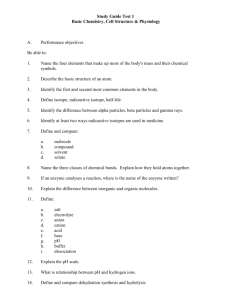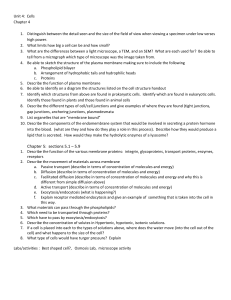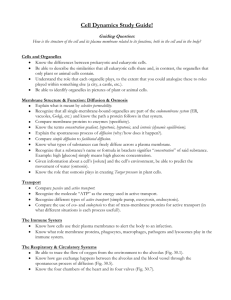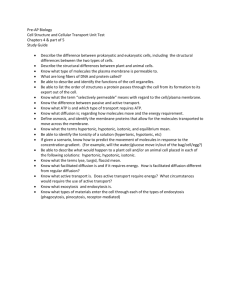Chapter 5.3 Notes
advertisement
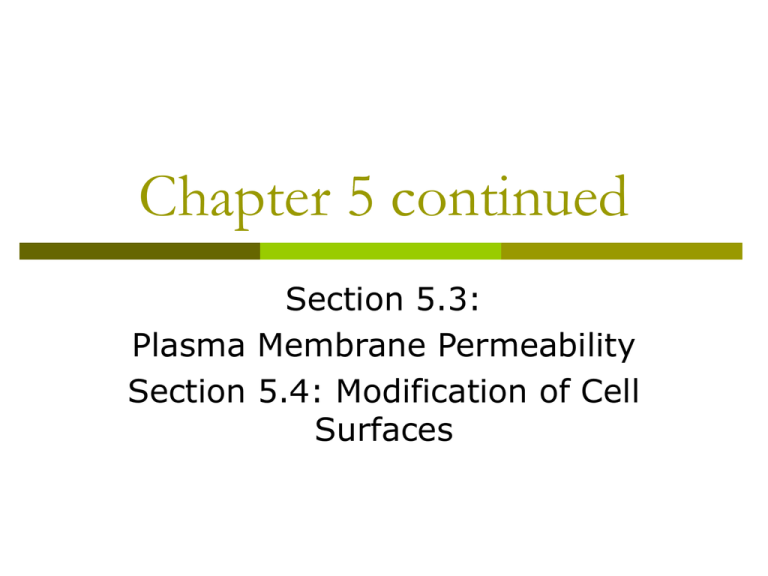
Chapter 5 continued Section 5.3: Plasma Membrane Permeability Section 5.4: Modification of Cell Surfaces The Plasma Membrane Is selectively permeable See table 5.1, page 88: explains which type of molecules cross the membrane and whether or not energy is required The movement of molecules through the cell membrane follows concentration gradients (areas where molecules are less concentrated to areas where they are more concentrated) Diffusion Movement of molecules from higher to lower concentration – DOWN concentration gradients Diffusion will continue until equilibrium is achieved Solution: contains a solute and a solvent Solute: particles which dissolve Solvent: liquid in which solvent dissolves See fig. 5.7, p. 89: gas exchange in lungs Osmosis The diffusion of water across a selectively permeable membrane due to concentration differences Water will move toward where there is more solute This will result in more water where there was less water before Osmosis will occur due to osmotic pressure, and will occur in hypotonic and hypertonic solutions. Osmosis will not occur in isotonic solutions Osmosis con’t Osmotic pressure: water diffuses across a membrane due to this; the greater the possible osmotic pressure, the more likely it is that the water will diffuse in that direction Isotonic solution: water and solute concentration are the same on the inside and outside, there is no movement of water in either direction. IV solutions usually are isotonic, the same concentration as body cells. Osmosis con’t HYPOTONIC Solution: solutions that cause a cell to swell, or even burst, due to an intake of water, are hypotonic. In this type of solution, there is more solute in the cell, and water rushes in. When a cell bursts due to a hypotonic solution, this is called cytolysis A plant cell in a hypotonic solution will not burst, but will become rigid. This is due to the cell wall which supports the plant cell. Osmosis con’t HYPERTONIC solution: solutions that cause cells to shrink or lose water pressure. This will happen if there is more solute surrounding the cell than is present in the cell. This is because water will rush out of the cell to where there is more solute. When a cell shrinks due to being in a hypertonic solution this is called crenation. Red Blood cells & osmosis….. Cellular Transport by Carrier Proteins Some proteins in the cell membrane transport biologically useful molecules into and out of the cell These two types of cellular transport are facilitated transport and active transport ; the top image is facilitated; the bottom is active Facitilated Transport The passage of molecules such as glucose and amino acids although they are not lipid-soluble Like diffusion, does not require expenditure of energy as molecules are moving down their concentration gradients, in the direction they tend to move anyway See fig 5.10 Active Transport Molecules or ions moving into and out of the cell, accumulating there. This is opposite of the process of diffusion, because it is movement against the concentration gradient. Examples in the body are: iodine collecting in thyroid cells, sodium being withdrawn from urine by kidney tubules Chemical energy usually in the form of ATP is required for this The sodium-potassium pump Associated with nerve and muscle cells Moves sodium ions to the outside of the cell and potassium ions to the inside Results in both a solute-concentration gradient, and an electrical gradient (because of the ionic charges) Because of this pump, the inside of the cell becomes negatively charged See fig. 5.11 Vesicle Formation Exocytosis: enables cell to secrete substances such as hormones, neurotransmitters, and digestive enzymes In exocytosis, a vesicle forms, usually produced by the golgi body, and fuses with the cell membrane, excreting it’s contents from the cell See fig. 5.12 Endocytosis: opposite of exocytosis, when cells take in substances through vesicles. Occurs in one of three ways: phagocytosis, pinocytosis, receptor-mediated endocytosis Endocytosis: three types Phagocytosis: when material taken in by endocytosis is large, such as a food particle or another cell. Fig. 5.13 a Pinocytosis: when vesicles form around liquid or other very small particles;Fig 5.13 b Receptor-mediated endocytosis: uses a receptor protein shaped in such a way that a specific molecule can bind to it, such as a vitamin, peptide hormone, or lipoprotein; fig. 5.13 c Modification of Cell Surfaces Most cells have extracellular structures which allow them to coordinate or provide structure There are two types of animal cell surface features: junctions between cells, and extracellular matrix, which supports the cell and also affects it’s behavior Junctions between Cells Anchoring junctions: adhesion junctions and desmosomes. Serve to mechanically attach adjacent cells. See fig. 5.14 a Adhesion junctions: where intercellular filaments run between two cells which results in a sturdy but flexible sheet of cells; found in heart, stomach, bladder, where cells can get stretched Desmosomes: a single point of attachment of adjacent cells. Common between skin cells Junctions between cells continued Other types of junctions are tight junctions and gap junctions see fig. 5.14 a&b Tight junctions: plasma membrane proteins attach to each other, producing a zipper-like fastening. Cells of tissues that serve as barriers are held together by tight junctions such as in the intestine to keep intestinal fluids in or kidneys to keep urine in the tubules Gap junctions: allows cells to communicate. Forms when two identical plasma membrane channels join. Lends strength to cell and allows small molecules and ions to pass between Extracellular Matrix A meshwork of polysaccharides and proteins in close association with the cell that produced them Two well-known structural proteins in the e.m. are collagen (for strength) and elastin(for resilience) Other proteins and polysaccharides are fibronectin and laminin, amino sugars, proteoglycans Varies between being flexible (in cartilage) to rigid (in bone) See fig. 5.15 Plant cell walls All plant cells have a primary cell wall which varies in thickness This cell wall contain cellulose fibers, pectin, and polysaccharides. Plant cells are joined by plasmodesmata, which are numerous narrow membranelined channels. The plasmodesmata allow water and small molecules to pass from cell to cell. Homework Study questions, chapter 5 Review ch. 4 and study ch. 5 Lab report due TH! See board for modified schedule for rest of qtr! Including today, only5 class periods left of qtr 1!!!


